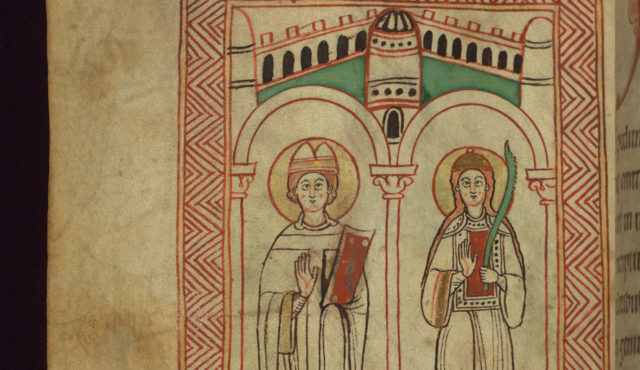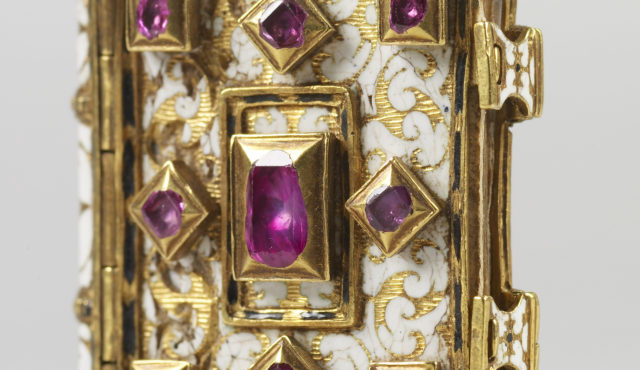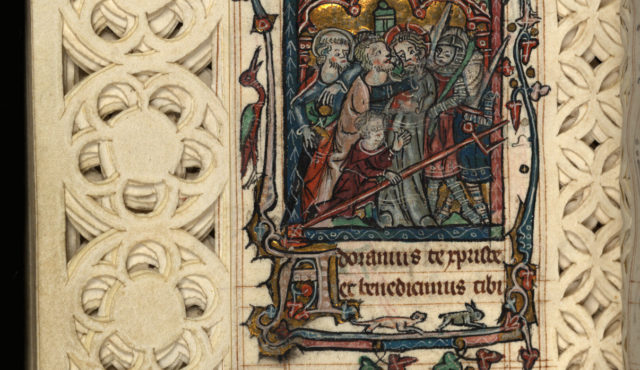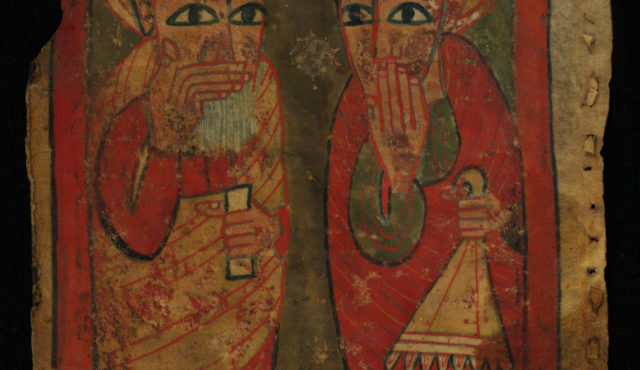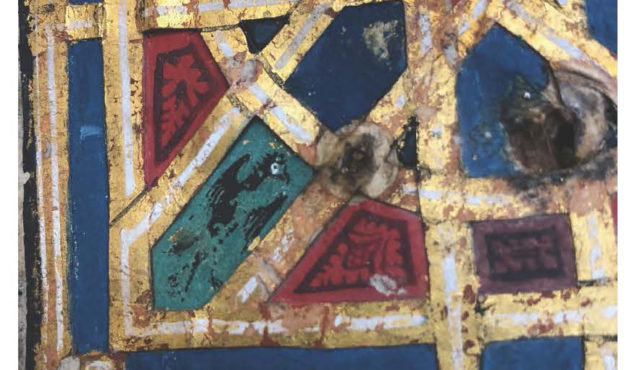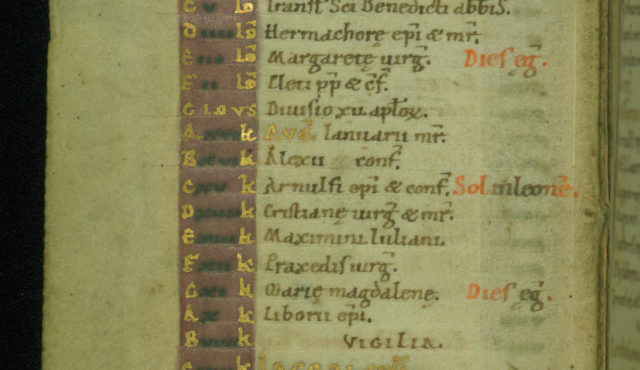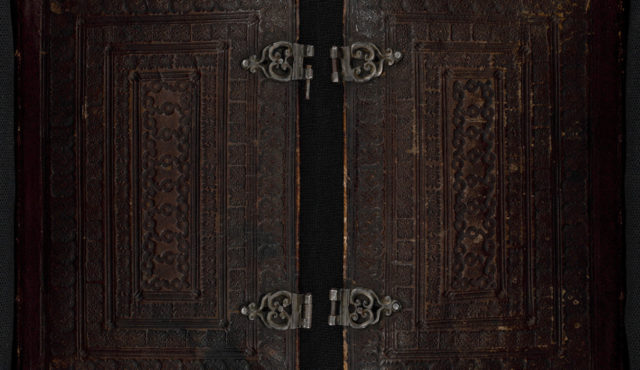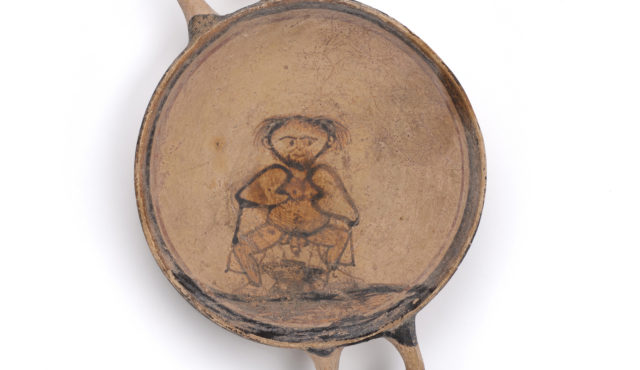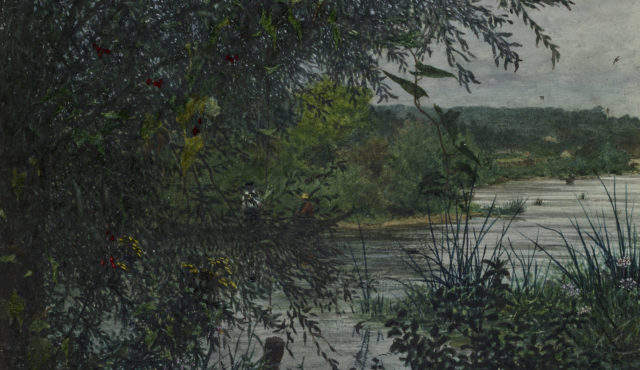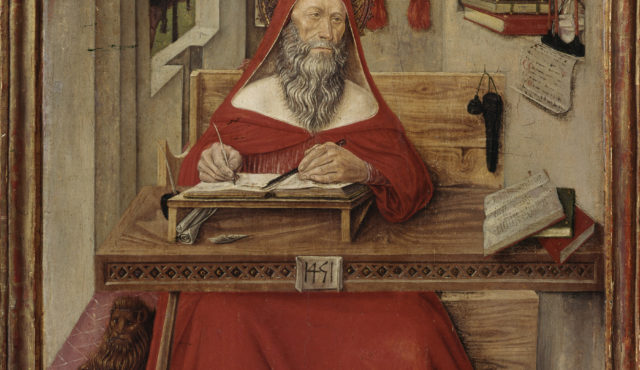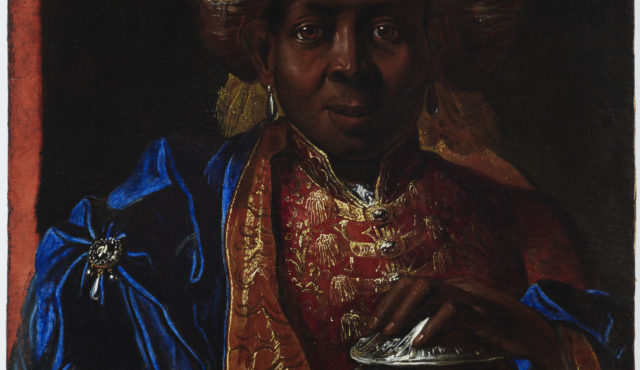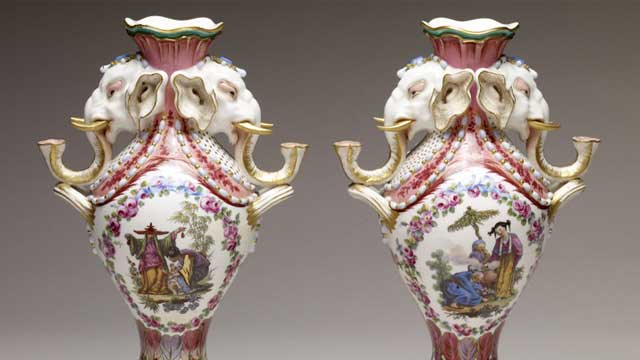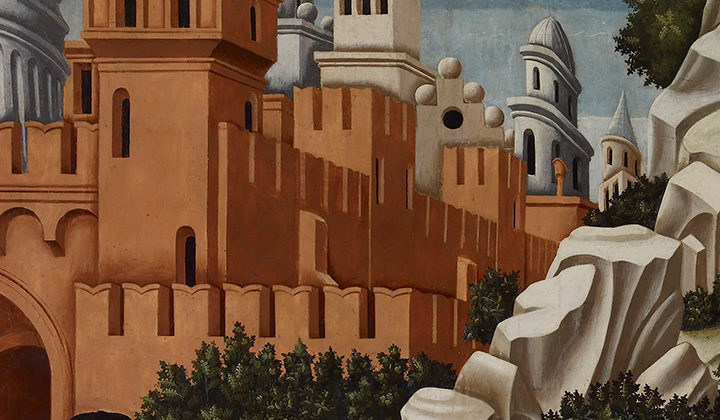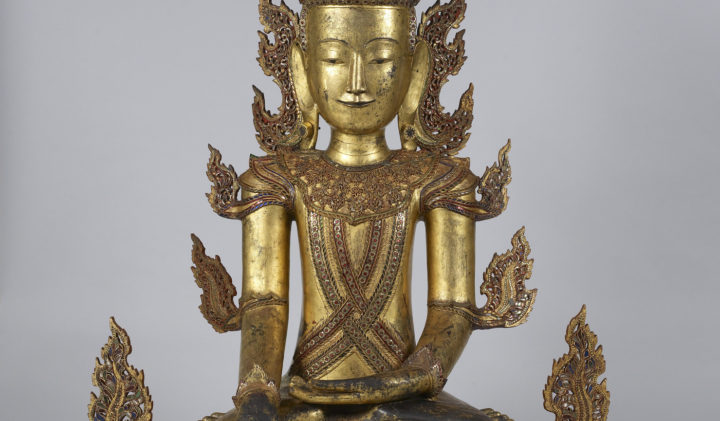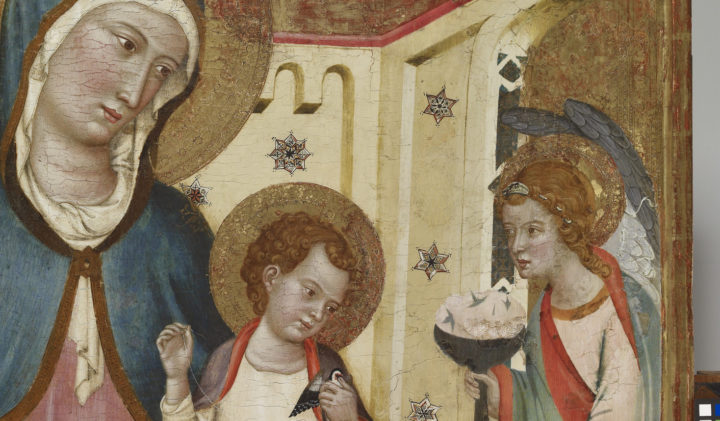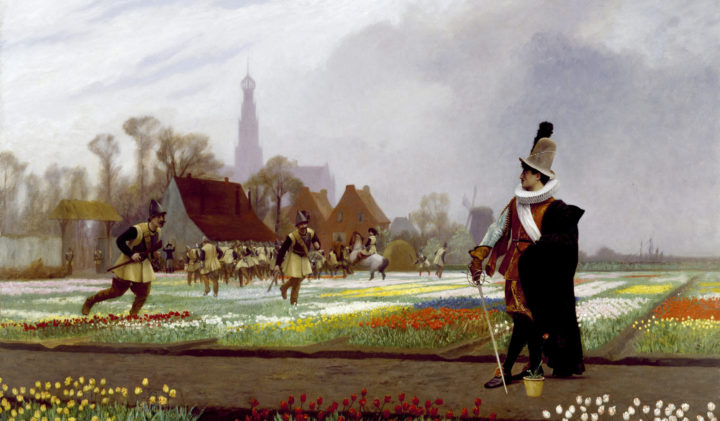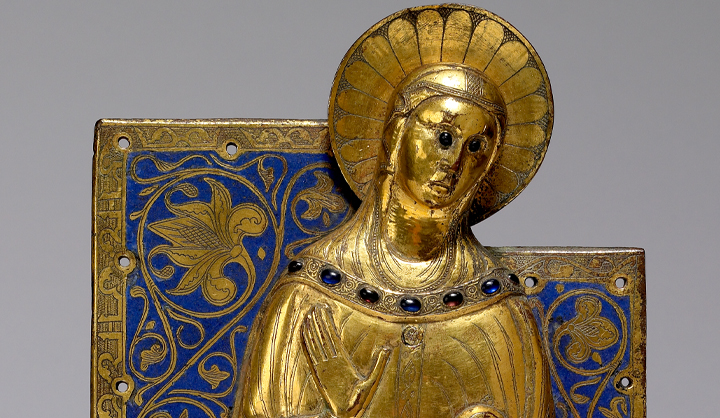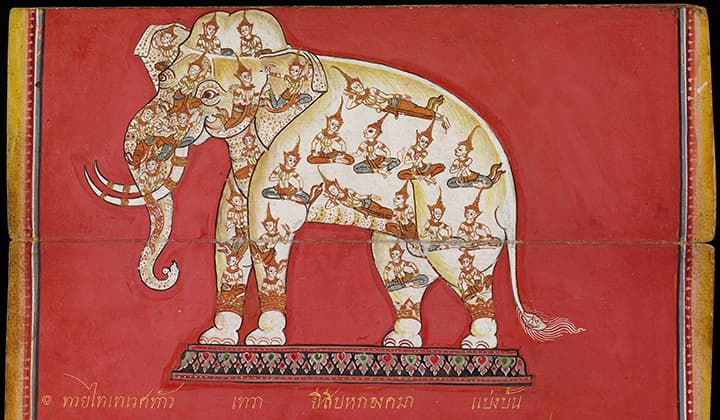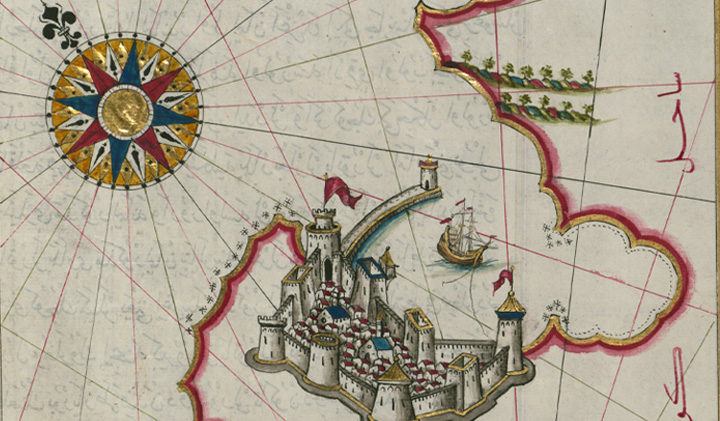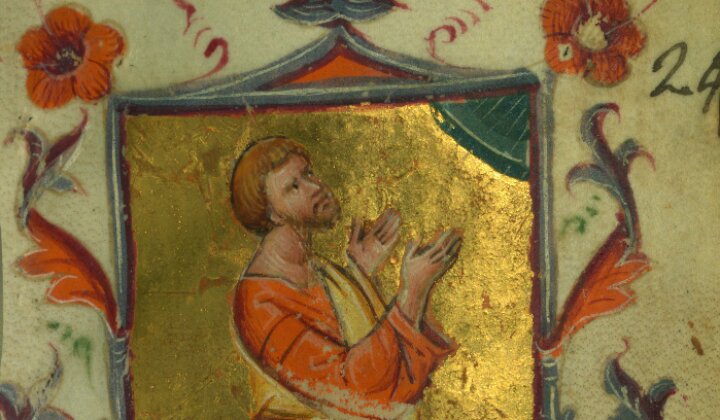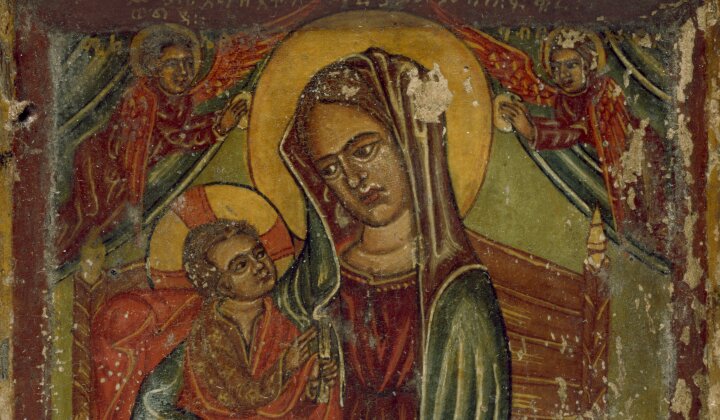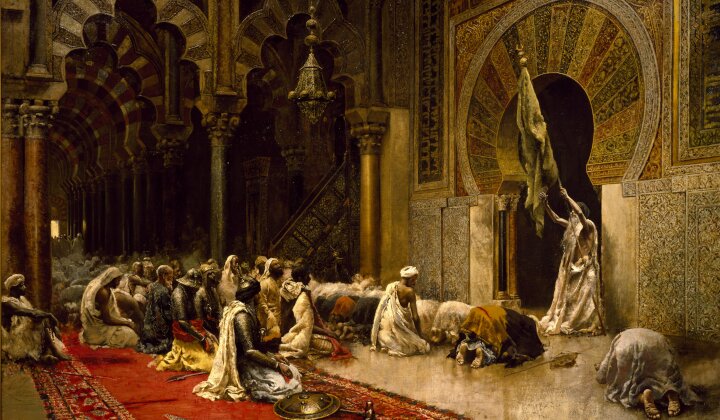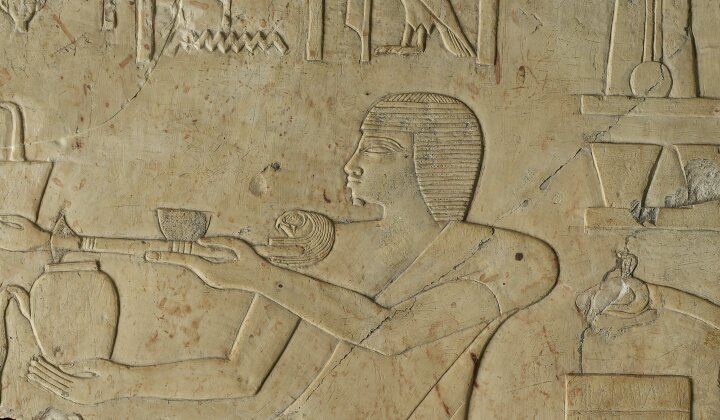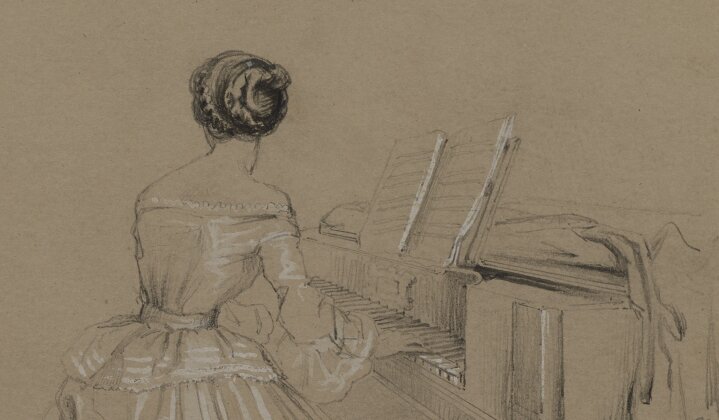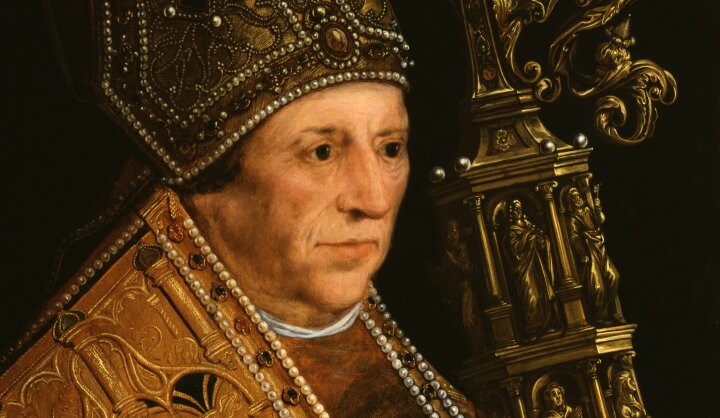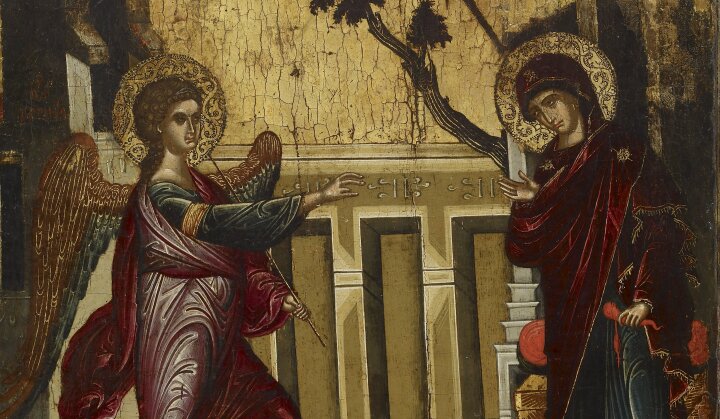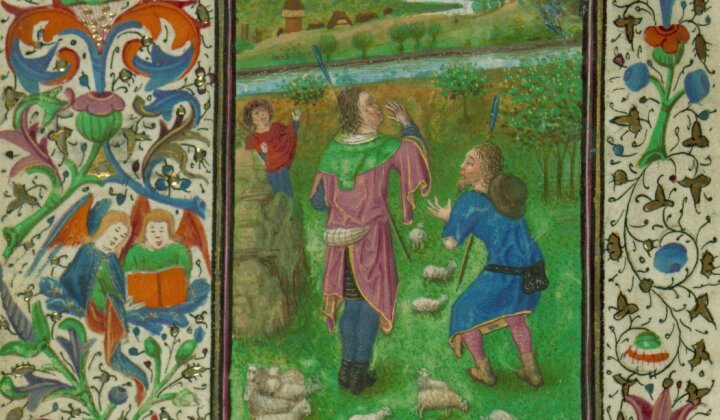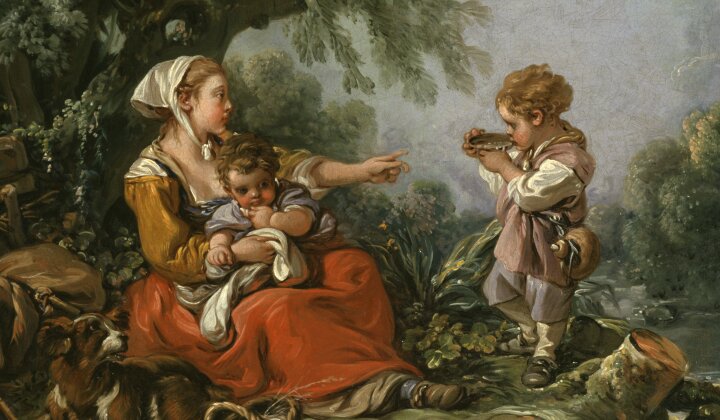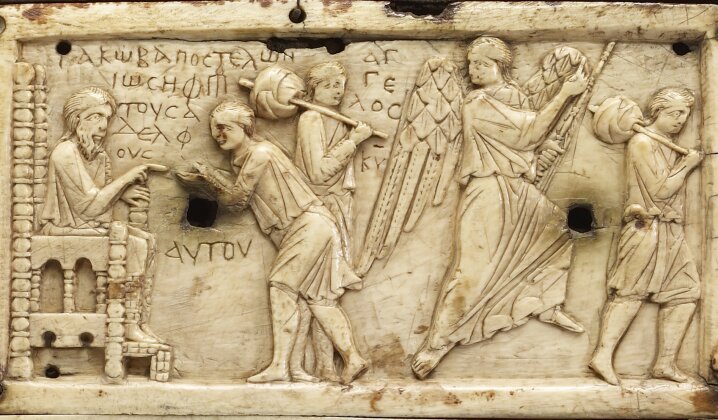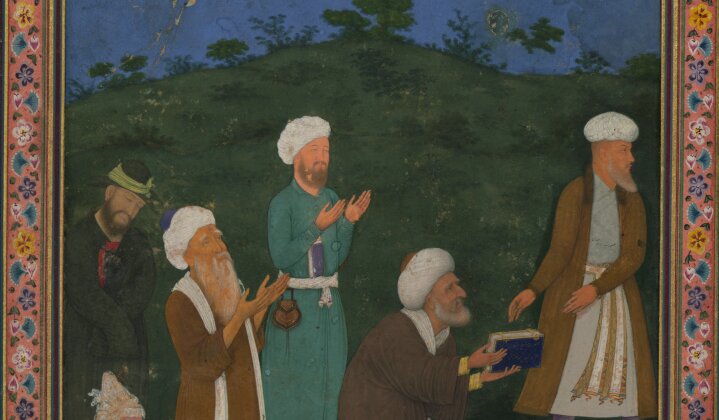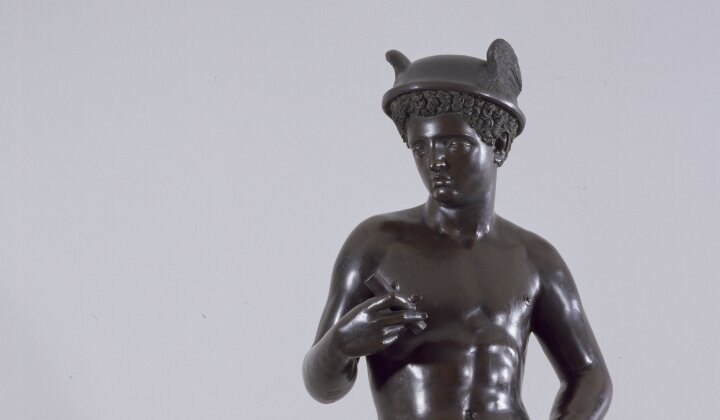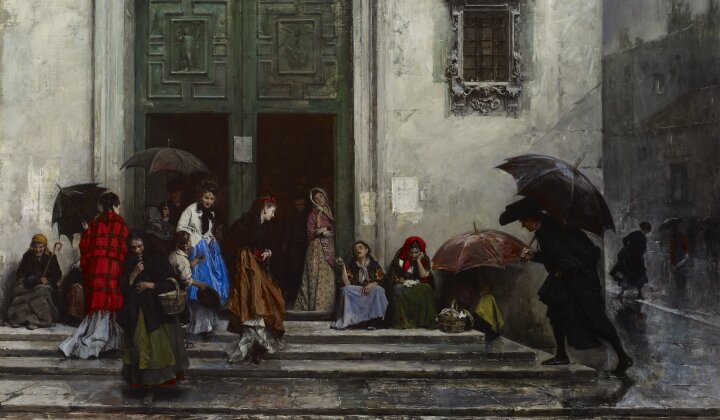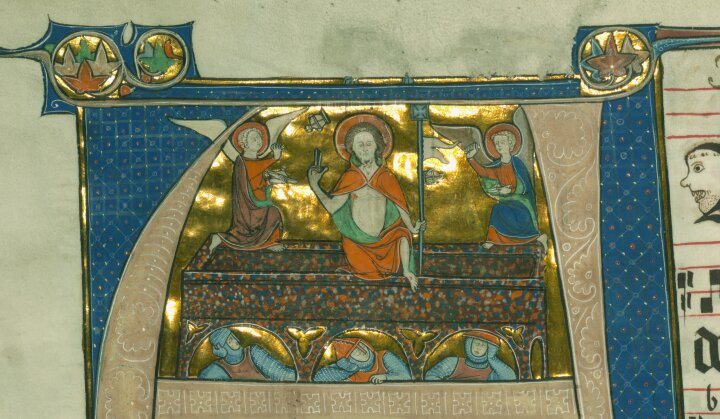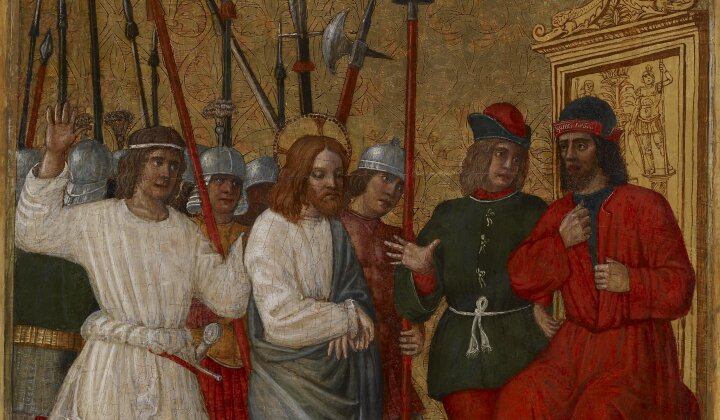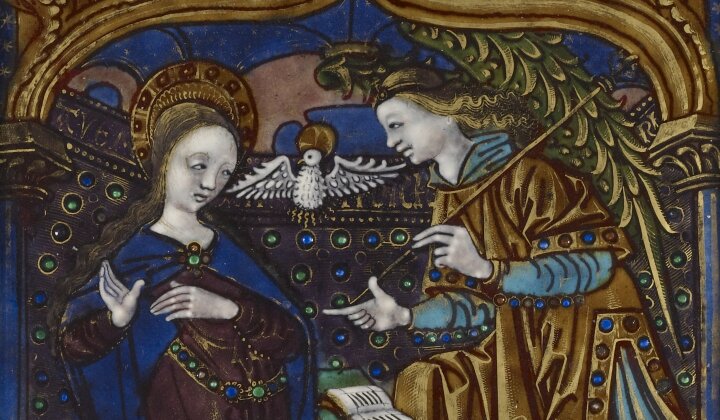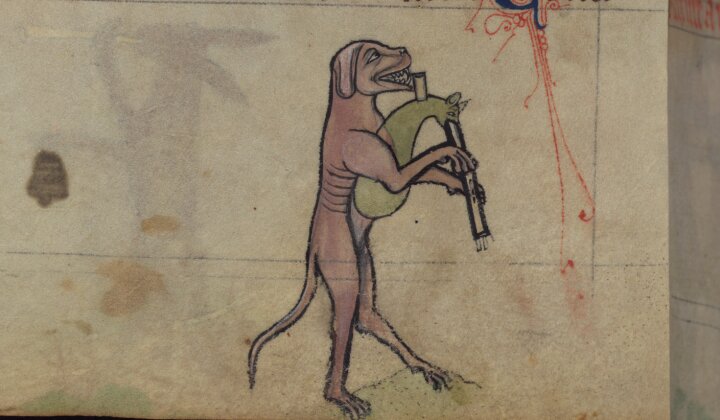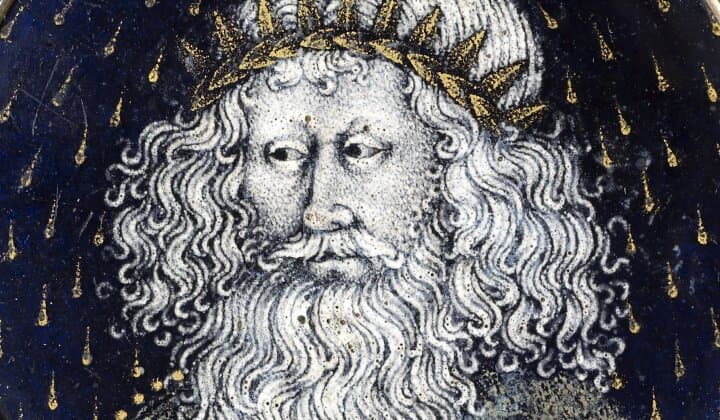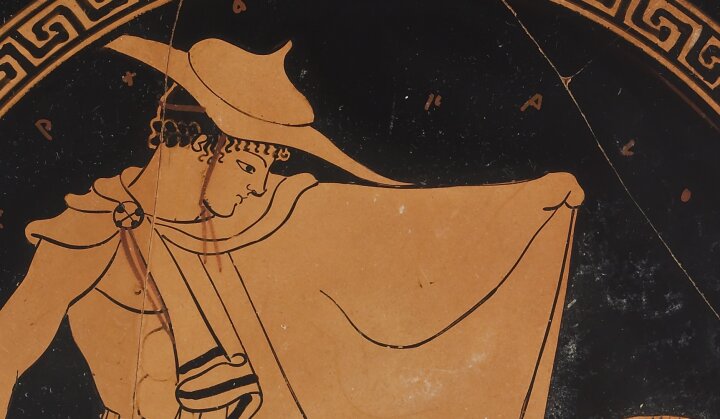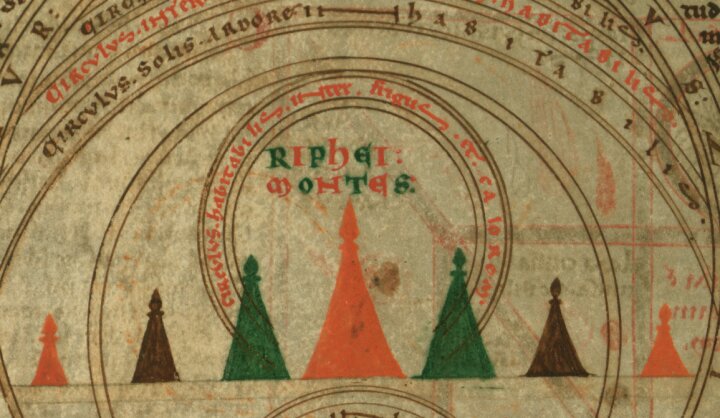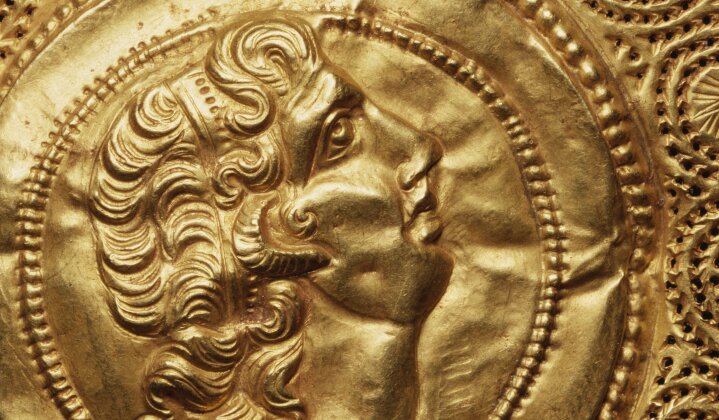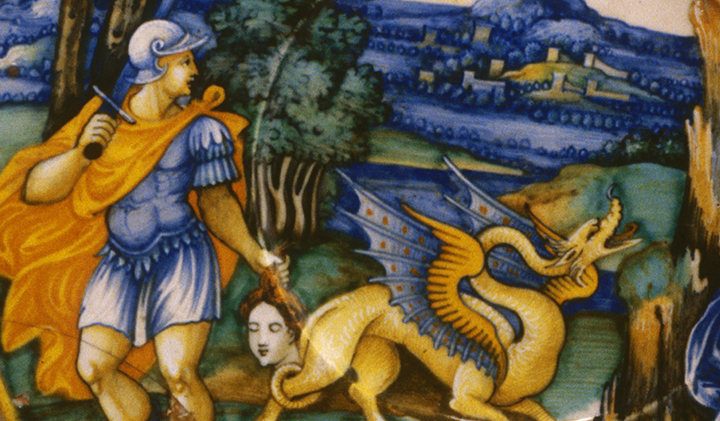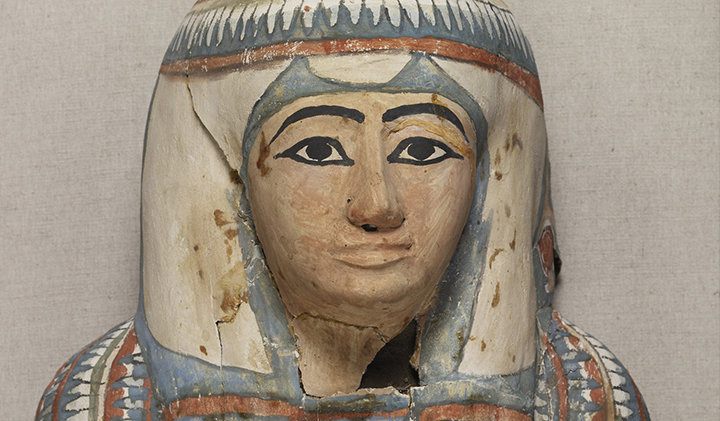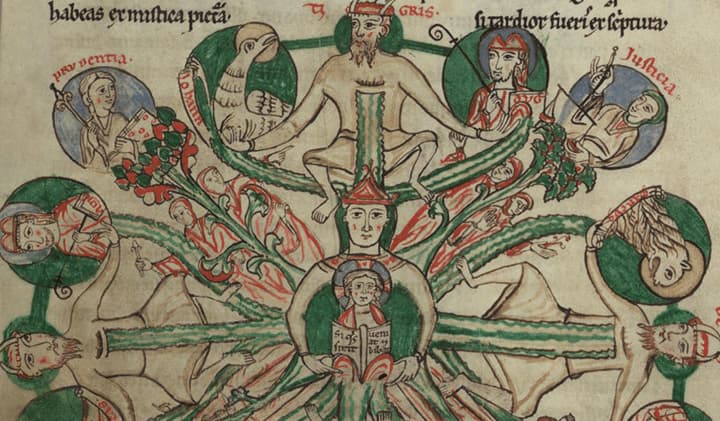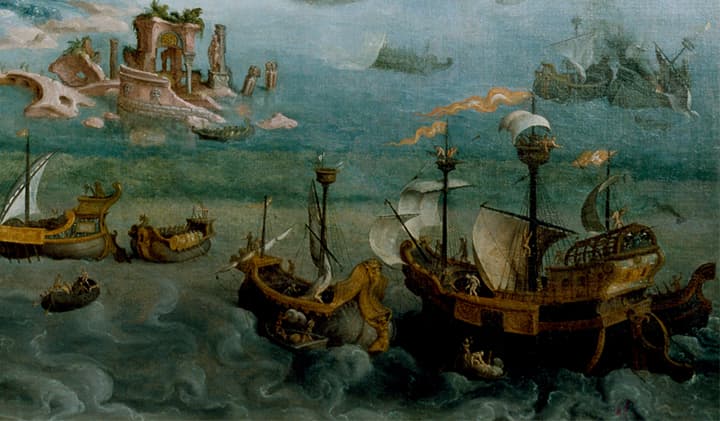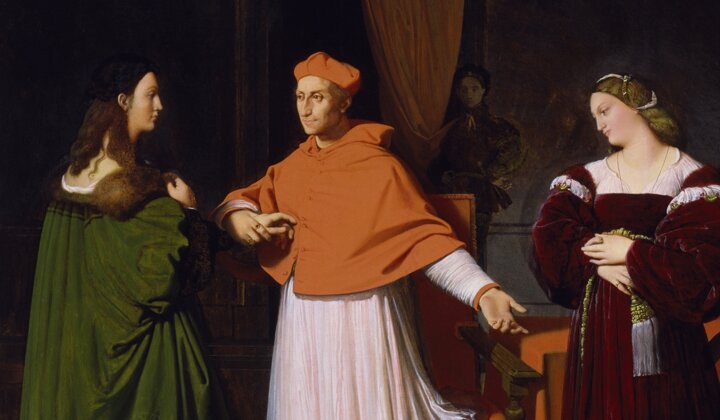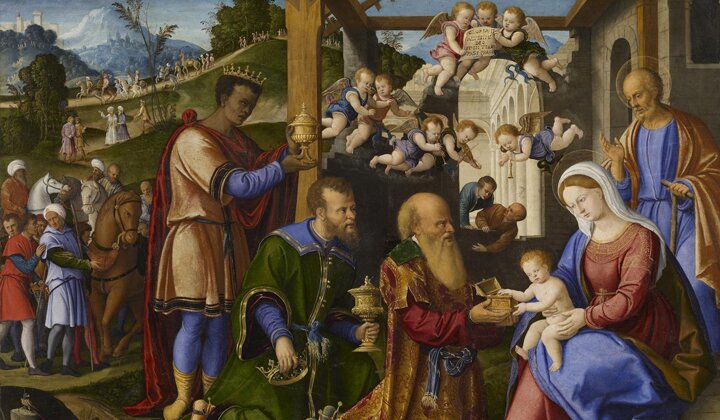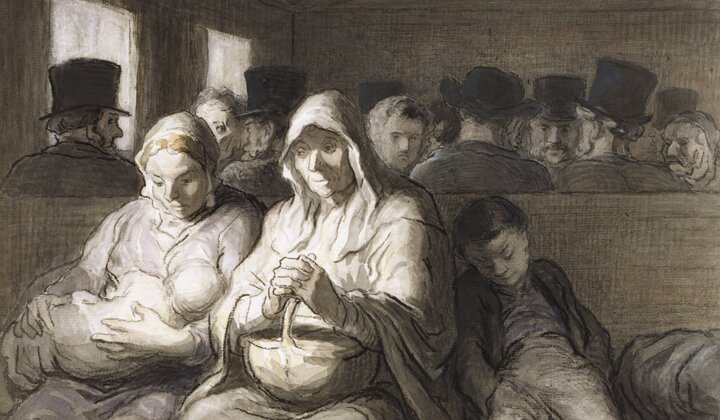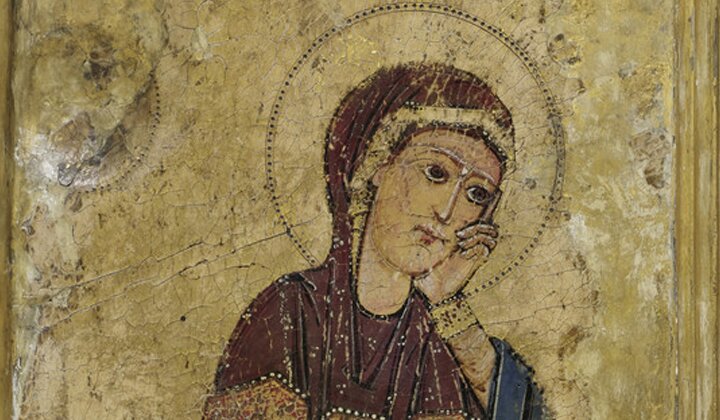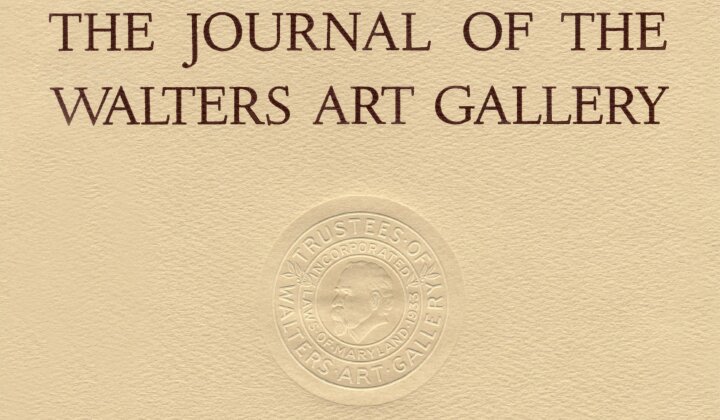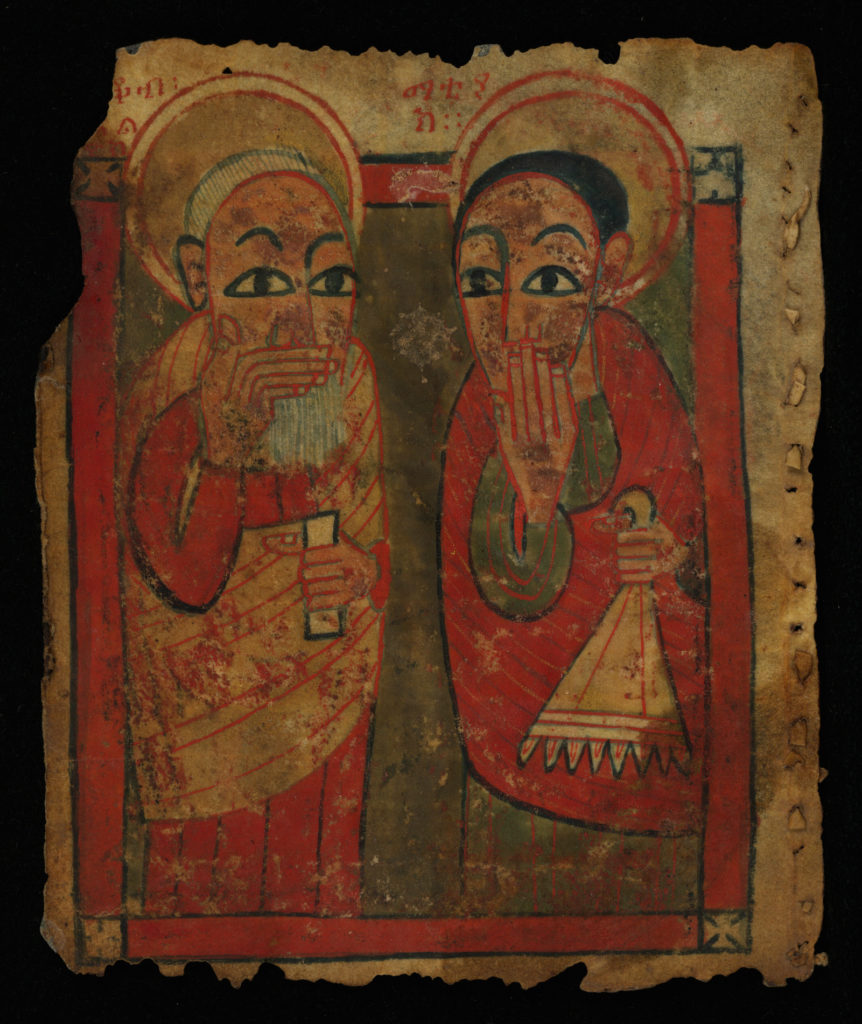
Unknown Ethiopian artist, Saints James (Jacob) and Matthias, Ethiopia (Gunda Gunde), early sixteenth century, parchment with ink and paint. The Walters Art Museum, Baltimore, gift of Rev. R. K. Le Fleur, 2014, acc. no. W.927 (verso)
As the second oldest Christian nation in the world, Ethiopia has a long tradition of visual culture created to support the needs of the Ethiopian Orthodox Church and its liturgy. Although there is evidence of a much earlier tradition, the earliest surviving illuminated manuscripts from Ethiopia and Eritrea date to at least as early as the fourteenth century, and most are Gospel books and psalters in the form of codices, or bound books.[1] When illuminated, Ethiopian Gospel books feature canon tables (charts with concordances between the four Gospel texts) with colorful architectural frames, Evangelist portraits, and sometimes prefatory miniatures with scenes from Christ’s life. A large number of these books have survived intact; however, as with European illuminated manuscripts, due to certain collecting habits, decorated leaves were sometimes removed from their original codicological context.
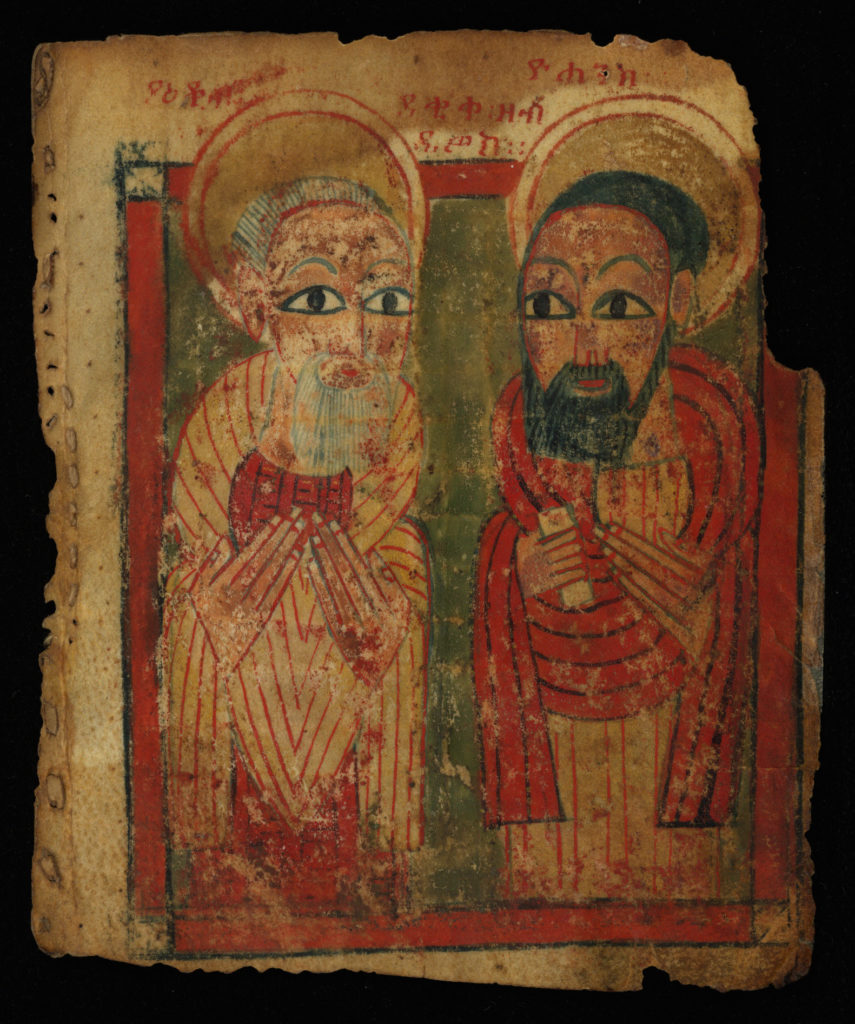
Unknown Ethiopian artist, Saints James and John, Sons of Zebedee, Ethiopia (Gunda Gunde), early sixteenth century, parchment with ink and paint. The Walters Art Museum, Baltimore, gift of Rev. R. K. Le Fleur, 2014, acc. no. W.928 (verso)
In 2014, the Walters Art Museum was given three parchment leaves illuminated on both sides and displaying a total of six miniatures depicting various saints (fig. 1, 2, 3), as well as Our Lady Mary with Her Beloved Son and the Archangels Michael and Gabriel.[2] Although the full-page format of the illustrations suggests that they represent a series of miniatures from a prefatory image cycle found at the beginning of a codex, and although the acquisition report for the leaves suggested that they were from a hagiographical manuscript about the lives of various saints, Abigail Quandt, the Walters’ Head of Book and Paper Conservation, had noted remnants of parchment lacing or stitching along one edge of each leaf. This is inconsistent with the sewing stations one would see in an Ethiopian or European codex, with bifolia bound together with thread stitched down their center margin.[3] It is, however, completely consistent with a book type particular to Ethiopia.
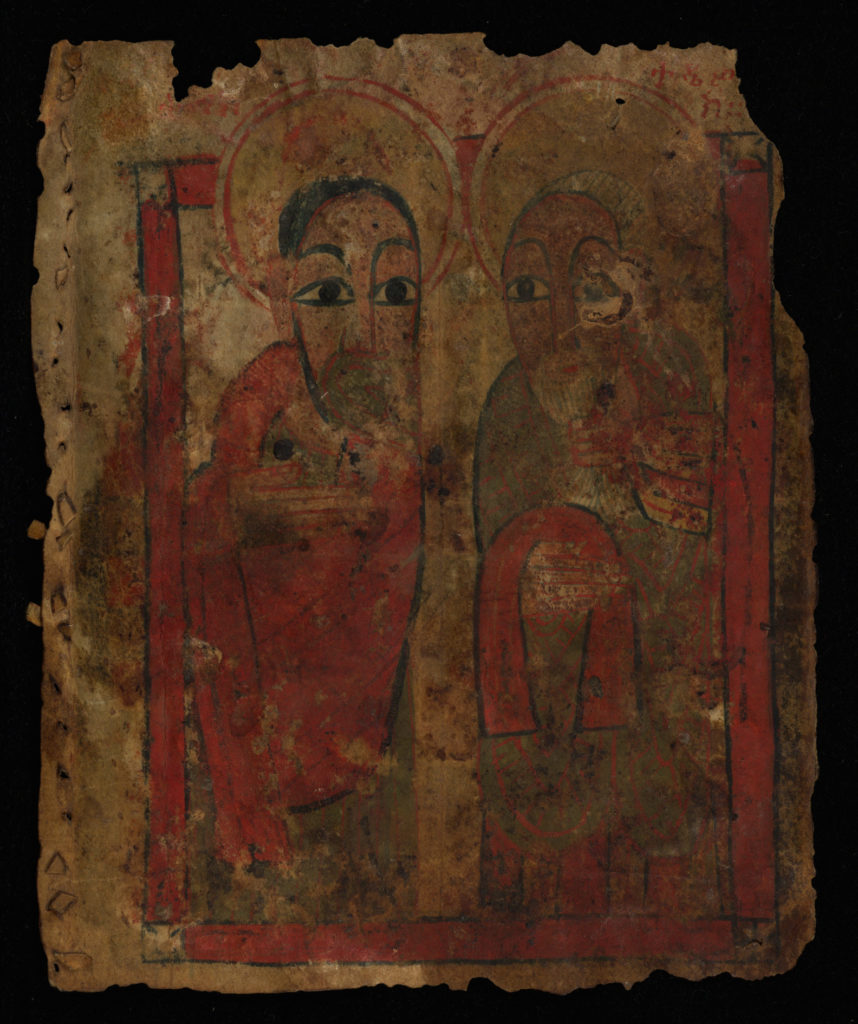
Unknown Ethiopian artist, Unidentified Saint and Saint Thaddaeus, Ethiopia (Gunda Gunde), early sixteenth century, parchment with ink and paint. The Walters Art Museum, Baltimore, gift of Rev. R. K. Le Fleur, 2014, acc. no. W.929 (recto)
These so-called sensuls, or chained manuscripts, first appeared in Ethiopia in the late fifteenth century, and they experienced a second flourishing in the seventeenth century.[4] Sensuls consist of either a single sheet or multiple sheets of parchment sewn together and folded accordion-style. Their folios are most often illuminated on one side with a series of full-page images, one immediately after the other, and they often lack text beyond simple inscriptions identifying the figures depicted. Sensul iconography typically takes one of two forms: a series of icon-like depictions of various saints and holy figures (as seen in most earlier examples from the fifteenth and sixteenth centuries), or a collection of narrative scenes drawn from the Bible or a saint’s life (beginning in seventeenth-century examples). This article will explore the Ethiopian sensul in terms of its construction and decoration, as well as the various implications of its particular format on its use in prayer and devotion. It will also propose that some of the single Ethiopic leaves or bifolia that survive today have been misidentified as coming from codices. Close study of their codicological features reveals that they derive from sensuls, which has significant implications for how these images were experienced and understood by their viewers.

Unknown Ethiopian artist, Processional Icon in the Shape of a Fan, Ethiopia (Gunda Gunde), late fifteenth century,tempera with ink on parchment. The Walters Art Museum, Baltimore, museum purchase with funds provided by the W. Alton Jones Foundation Acquisition Fund, 1996, acc. no. 36.9
Based on the style of the miniatures found on the Walters’ disbound sensul leaves, they were likely produced at the monastery of Gunda Gunde in the Christian Highlands of Ethiopia.[5] The scriptorium there flourished in the late fifteenth and early sixteenth centuries, and it took some of the most creative approaches to the manuscript arts in the history of Ethiopia and regions beyond. It produced the earliest Ethiopian sensuls, as well as other parchment objects such as a painted processional icon in the Walters collection (fig. 4).[6] This unusual piece consists of five sheets of parchment glued together, scored, and then accordion folded, like a sensul. Each thin vertical “panel” created by the folds is completely filled with a standing biblical figure or saint, identified by an inscription in Ge’ez (classical Ethiopic), and the figures are framed at top and bottom by horizontal borders filled with abstract designs evoking plants or perhaps birds. Each end of the horizontal parchment was likely originally attached to a thin wood panel, which was in turn attached to a staff, creating a circular icon in the shape of a fan.[7] In this configuration, the figure of Mary appears at the apex, flanked on either side by thirty-eight Old and New Testament figures, as well as saints. Viewed head on, the figures of apostles and saints appear to converse with each other in pairs. Art historian Marilyn Heldman has stated that these fans were created in response to the need for Marian icons as king Zä’ra Ya’eqob instituted the mandatory veneration of Mary in the mid-fifteenth century.[8] Indeed, it appears that objects in this fan format was produced only in the second half of the fifteenth century, during and just after the king’s reign. Both the medieval Western Christian Church and the Eastern Orthodox Christian Church employed decorative liturgical fans during the Mass, with the primary purpose of discouraging flies from landing on the Eucharistic bread and wine.[9] In the case of the Ethiopian examples, however, these objects function primarily as portable icons. When extended horizontally and viewed obliquely, the fan’s figures appear to walk in linear formation, reflecting the use of the object itself in religious processions, an idea to which I will return later (fig. 5). Other parchment objects from Gunda Gunde display imagery exhibiting similar linear movement, as in a sensul decorated with a long lineup of saints in the Peabody Essex Museum collection, and a Gospel book in the J. Paul Getty Museum with prefatory images featuring multiple rows of holy figures arranged in registers.[10]
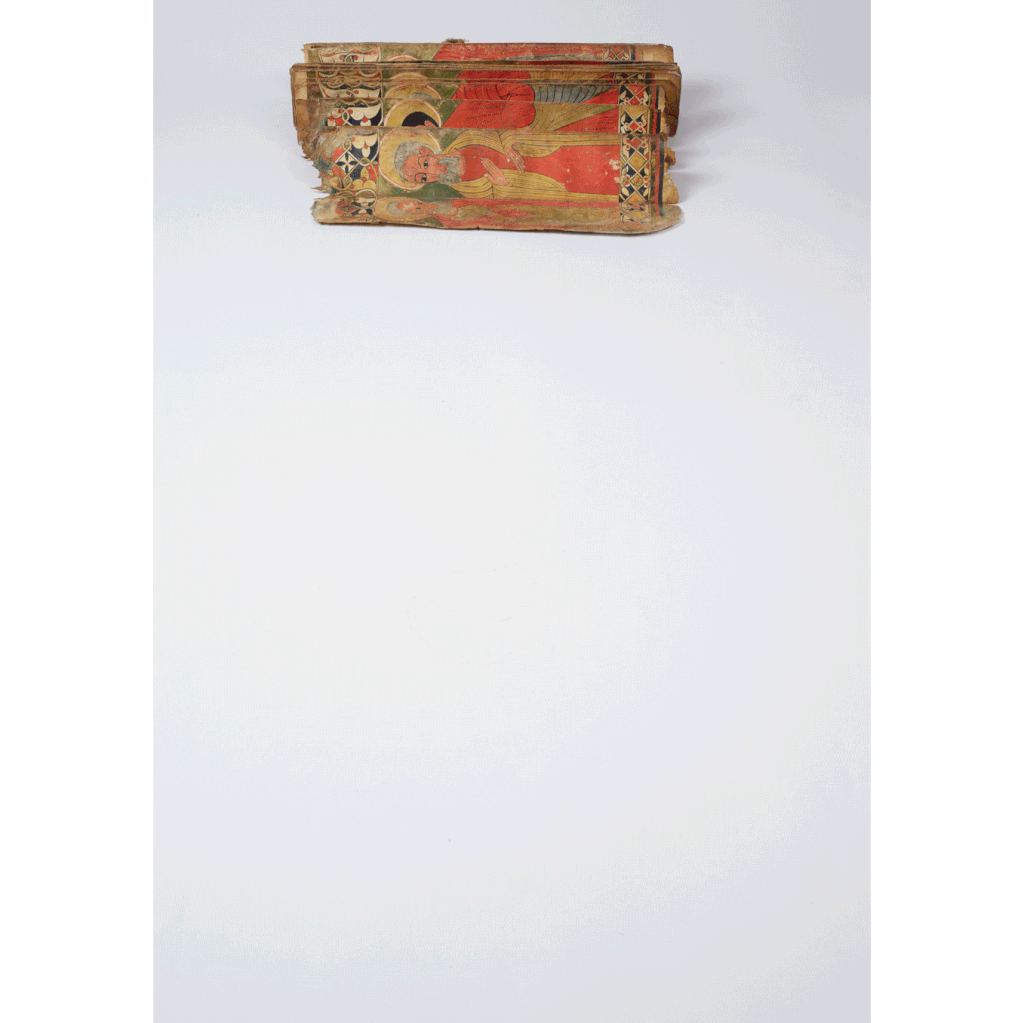
GIF showing Folding Processional Icon extending horizontally, acc. no. 36.9

Unknown Ethiopian artist, Sensul, Ethiopia (Gondar), late seventeenth century, ink and pigments on medium weight parchment, reinforced with heavier parchment backing covered with upper and lower boards made of heavy undecorated hide, stitched to ends of parchment strip, unfolded H: 3 x W: 23 in. (7.62 x 58.42 cm); each panel H: 3 5/8 x W: 3 1/8 in. (9.2 x 9 cm). The Walters Art Museum, Baltimore, museum purchase with funds provided by the W. Alton Jones Foundation Acquisition Fund, 1996, acc. no. 36.10
In addition to the three Gunda Gunde sensul leaves discussed above, the Walters collection includes a complete sensul from late seventeenth-century Gondar (fig. 6).[11] When stretched out to its full length, the viewer sees a series of scenes from the Life of the Virgin Mary, creating a special kind of continuous narrative, akin to prefatory cycles in Ethiopian Gospel books, but even more fluid in its presentation. Art historian C. Griffith Mann has noted that when the sensul is kept mostly closed and leafed through like a book, a series of diptychs is created (fig. 7).[12] Quite often, the centermost diptych in Ethiopian sensuls pairs an iconic image of the Virgin and Child with one of Saint George, who is of central importance in the Ethiopian Orthodox Church. This Gondarine manuscript is palm-sized, measuring about 3 ½ inches square, thus it could be used like a devotional painting held at close range for personal meditation.

GIF showing Sensul extending horizontally, acc. no. 36.10
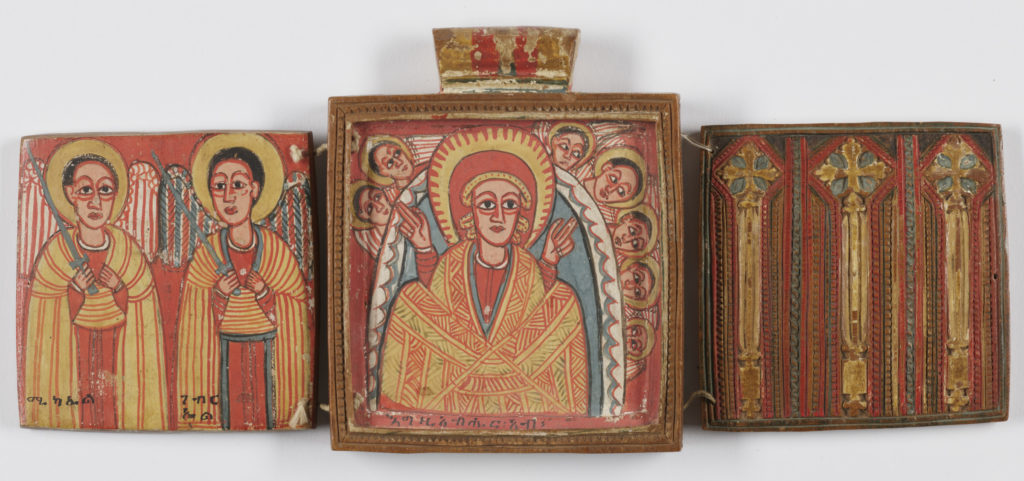
Unknown Ethiopian artist, Double-sided Diptych with Mary at Dabra Metmaq, Ethiopia (Gondar), late seventeenthcentury, tempera on panel. The Walters Art Museum, Baltimore, museum purchase with funds provided by the W. Alton Jones Foundation Acquisition Fund, 1996, acc. no. 36.8

Unknown Ethiopian artist, Prayer Scroll with Archangel Michael and a Cross, Ethiopia, late nineteenth-early twentieth century (?), parchment with ink. The Walters Art Museum, Baltimore, gift of Dr. John R. and Rose Mary Iddings, 2001, acc. no. 2001.32.7
The size and function of the sensuls discussed above recall other religious objects from Ethiopia intended for individual use. For example, small double-sided diptych icons painted with images of saints could be worn hanging from a cord around the neck (fig. 8).[13] Keeping these images of holy figures close to the breast served a protective function for the wearer. Like sensuls, Ethiopian healing scrolls display text and images down their entire length, which typically matched the height of the person who commissioned it. These scrolls, oriented vertically rather than horizontally, and inscribed with apotropaic (protective) and medicinal prayers for the owner, could be encased in a cylindrical leather capsule designed to be worn as a necklace, or they could be hung above the owner’s bed for protection (fig. 9).[14] Mann has suggested that sensuls, such as the Walters example from Gondar, could be worn on the body or hung above a bed in a similar way to scrolls.[15]
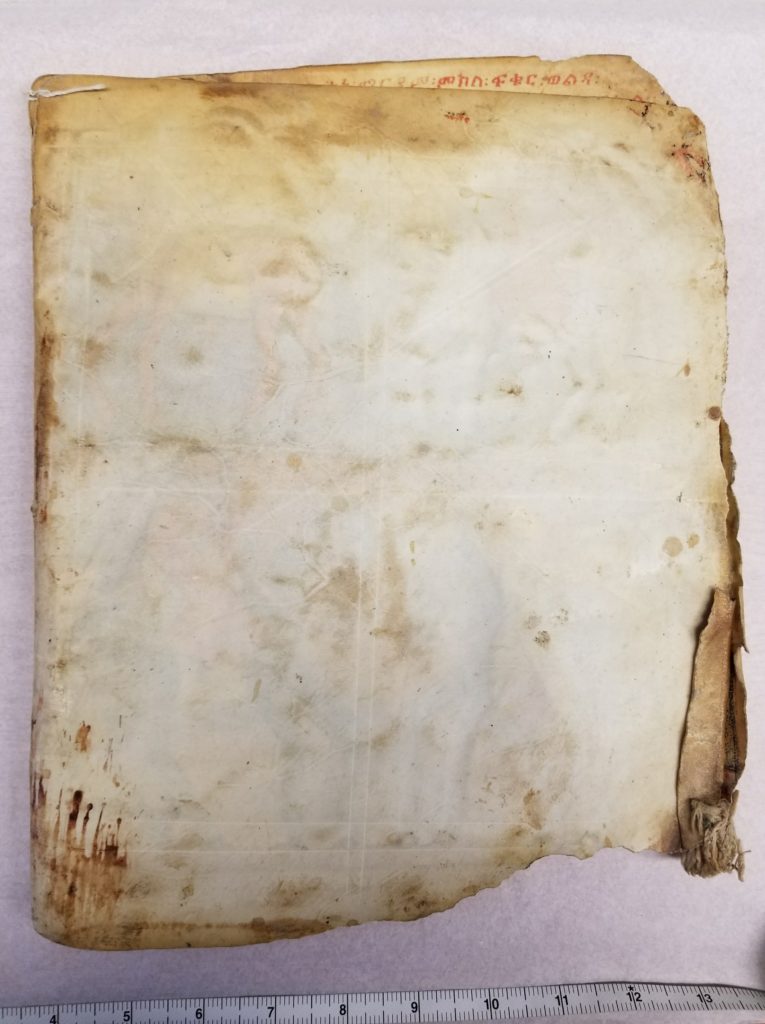
Unknown Ethiopian artist, Bifolium from a Sensul, Ethiopia, early sixteenth century, parchment with ink and paint, H:11 3/4 x W: 19 1/8 in. (29.7 x 48.5 cm). Museum Fünf Kontinente, Munich, acc. no. 86-307 643. Image by author
While less plentiful than codices, sensuls are relatively common in Ethiopian cultural production. It is, therefore, very possible that some larger single disbound Ethiopian leaves that have been thought to come from Gospel books and psalters are actually from sensuls. I would argue that three large illuminated bifolia now in Munich, likely by the same artist as the Walters Gunda Gunde sensul leaves, are one such example.[16] When unfolded, the Munich examples measure approximately 11 7/8 x 19 ¼ inches (30 x 49 cm). Like the Walters sensul leaves, they display stitching along both their left and right edges, and the outer edges of the parchment sheet (what would be the fore edge, that is, the outer vertical edge of the page in a codex) are scored and folded back onto the reverse of each bifolia, which are blank (fig. 10). Although the Munich bifolia are much larger than the Walters sensul and sensul leaves discussed above, the former must have originally been sewn together concertina or accordion style and have functioned as a chained manuscript.

Unknown Ethiopian artist, Christian Album, Ethiopia, late seventeenth century, pigments on vellum. Minneapolis Institute of Art, the Robert J. Ulrich Works of Art Purchase Fund, acc. no. 2009.39.3a-rr
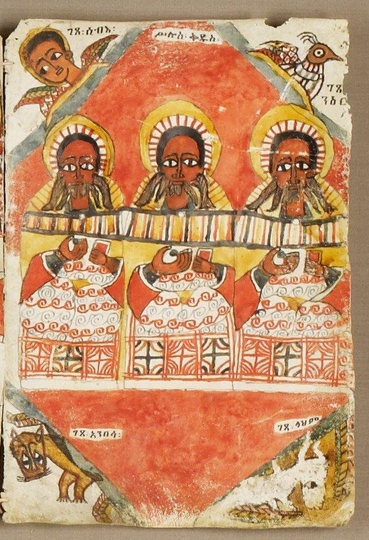
Detail, Christian Album, MIA, acc. no. 2009.39.3v
Another large-scale example is a group of forty-four single leaves in the Minneapolis Institute of Art (fig. 11).[17] They display scenes from the Hebrew Bible, the New Testament, and at the end, various Ethiopian saints. When acquired by the museum they were affixed to a large board, and not in their biblical order.[18] Close study, however, reveals that they display needle holes often around two, or even all four, sides. A few of the leaves display evidence that they were once part of bifolia, since they were torn unevenly along the vertical line scored down the center of a two-page spread (fig. 12).[19] The sewing is likely the result of the means by which they were attached to the backing board, but along the left and right edges, there is evidence of multiple sewing campaigns, and at least one probably represents the stitching that connected the leaves in a sensul format.
The Seattle Art Museum collection contains a group of twenty-eight Ethiopian leaves catalogued as Scenes from the Life of Saint George on parchment (fig. 13).[20] The folia are presently laid out on a large board in a grid-like pattern, much like the configuration of the Minneapolis leaves upon their acquisition. Each leaf is approximately 5 x 5 inches, and therefore exhibits the small, square format thought to be characteristic of sensul leaves. In keeping with the traditional composition of sensul leaves, the Seattle examples display a continuous visual narrative composed of individual full-page scenes from St. George’s life, with each image identified at the top by a caption in Ge’ez. They are stylistically similar to the Walters Gondarine sensul in terms of the particular modeling of the figures’ facial features, and the backgrounds composed of horizontal bands of red, yellow, and green, and therefore may be dated to the late seventeenth century. The leaves exhibit stitching with off-white or blue thread along at least one, but as many as all four sides, and they are stitched together so that they overlap. At the lower right corner of the assemblage appear to be two conjoint leaves with a single scene painted across their span. This hints at the manuscript’s original configuration either as a series of bifolia, or else as multiple pieces of parchment accordion folded several times and stitched together to form a long, horizontal chain.
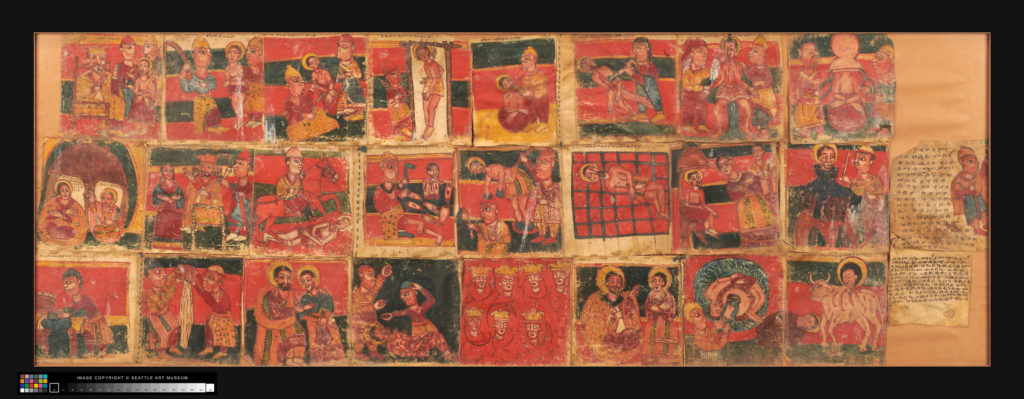
Unknown Ethiopian artist, Scenes from the Life of St. George, Ethiopia, ca. thirteenth century, pigment on parchment. Seattle Art Museum, gift of John W. Martin, acc. no. 45.71
Having now examined several examples of parchment objects from Ethiopia, the question remains: Why do Ethiopian painters favor images of holy figures displayed in series, especially in the case of sensuls?[21] The primary impetus seems to be a liturgical one. Art historian Ewa Balicka-Witakowska first referred to these repeated images of saints depicted on Ethiopian sensuls as a “painted litany.”[22] This presumably refers to Western Christianity’s use of repetitious prayers entreating various saints to pray for the faithful (e.g., a series often sung in canon: Saint Michael, pray for us, Saint Gabriel, pray for us, etc.). Indeed, litanies also play an important role in the Ethiopian Orthodox liturgy. Scholar of theology Habtemichael Kidane has laid out four different types of litanies used in the Mass and the Divine Office (a cycle of prayers said at set hours of the day).[23] The short litanies said before or, more often, after the lessons, known as the Wänǝbäl kʷǝllǝnä, seem to most closely mirror the serial imagery discussed above. These prayers are directed to God on behalf of various entities, such as the people, the king, armies, etc., but also for bishops, priests, and deacons, after each of which the faithful say, “We beseech you,” “hear us,” or “Lord have mercy.”[24] This repeated referral to clerics mirrors the uniformly laid out series of prophets and apostles found in the Getty’s Gunda Gunde manuscript, where the eye is drawn along by the shifts in color, and the subtle differences in the facial features of each holy figure and in the objects they hold.
A second aspect of Ethiopian liturgy may explain the strong presence of serial imagery in Ethiopian Christian art. The repeated rows of figures often represented in Ethiopian manuscripts and paintings evoke the appearance and experience of a religious procession. This practice played a central role in the medieval Ethiopian church and still does today. For example, philologist Getatchew Haile has pointed out that on the feast of Timkat, the January celebration of Christ’s Baptism, the clergy from the churches in various cities (Gondar, in particular) process down to the local river with crosses, tabots (or replicas of the Ark of the Covenant), and icons.[25] Priests and clerics line up side-by-side at the edge of the water, surrounded by the faithful, culminating in a crowded event filled with musical chant and swaying movement (fig. 14). The striking scene very much resembles the assemblage of figures on the icons themselves (fig. 4). In fact, many of the objects described above, including icons on wood panels and liturgical fans, were taken out of the churches that possessed them on holidays and carried aloft in procession.

Feast of Timkat, Ethiopia (Gondar), 2020. Image by author
Ethiopian sensuls, with their structural particularities and nuances, reinforce the idea that in manuscript studies it is crucial to pay close attention to various codicological features, including parchment scoring and folding, stitching holes, and thread remnants. In doing so, we may discover in the future that some single Ethiopian miniatures and leaves in fact originated from sensuls. Lacking long passages of texts to accompany the images, sensuls were like portable picture books. They allowed multiple icons to be carried by one person simultaneously. By folding and unfolding, one could generate visual dialogues between images, or create entire tableaux of holy figures. Likewise, complete narrative cycles, such as the Life of Christ or Mary, could fit in one’s pocket or be worn around one’s neck, close to the heart. Ultimately, the genre of Ethiopian sensuls speaks to the innovation of Ethiopian scriptoria to adapt the form and decoration of traditional manuscript codices to reflect devotional and liturgical practices particular to medieval Ethiopian Orthodox Christianity and the needs of the faithful.
[1] On the dating of early Ethiopian manuscripts, see Siegbert Uhlig, “Ethiopian Manuscripts and Paleography,” in Marilyn E. Heldman with Stuart C. Munro-Hay, eds., African Zion: The Sacred Art of Ethiopia (New Haven: Yale University Press, 1993), 57–58.
[2] Christine Sciacca, “A ‘Painted Litany’: Three Ethiopian Sensul Leaves from Gunda Gunde,” Journal of the Walters Art Museum 73 (2017): 92–95.
[3] The ragged edges of the Walters leaves makes it impossible to know if the extant leaves were conjoint in any way, nor is it possible to know how many leaves in the series may have been lost and what they depicted.
[4] Ewa Balicka-Witakowska, “Sənsul,” in Siegbert Uhlig, ed., Encyclopaedia Aethiopica 4: O‒X (Wiesbaden: Harrassowitz, 2010), 625.
[5] For a detailed discussion of the stylistic attribution, see Sciacca, “A ‘Painted Litany,’” 93–94.
[6] This is one of only four examples of such objects that are known to survive from Ethiopia, and the other three are found in the churches of Däbrä Tana Cherqos, Saint Mary at Däbrä Seyon, and Däbrä Selam in Ethiopia. See C. Griffith Mann in Deborah Horowitz, ed., Ethiopian Art: The Walters Art Museum (Baltimore: The Walters Art Museum, 2001), 114, cat. 17. … See report from the Ethiopian Heritage Fund: http://www.ethiopianheritagefund.org/completed-project-8-debra-tsion-and-debra-salem.
[7] The Walters processional fan does not display such wood panels, therefore C. Griffith Mann, then-Curator of Medieval Art at the Walters, based the idea of its original configuration on the example from Däbrä Seyon. See Mann, Ethiopian Art, 114, cat. 17.
[8] Heldman, African Zion, 95, cat. 7.
[9] For an example of a liturgical fan from the Western Church, see Herbert L. Kessler, “Images Borne on a Breeze: The Function of the Flabellum of Tournus as Meaning,” in Philippe Cordez, ed., Charlemagne et les objets: Des thésaurisations carolingiennes aux constructions mémorielles(Bern: Peter Lang, 2012): 57-85; and a forthcoming article by Kristina Potuckova.
[10] Peabody Essex Museum, Salem, Massachusetts, acc. no. E67892; J. Paul Getty Museum, Los Angeles, acc. no. Ms. 105 (2010.17).
[11] See Walters Art Museum, Baltimore, acc. no. 36.10.
[12] See C. Griffith Mann, Ethiopian Art, 116, cat. 18.
[13] On this piece, see Mann, Ethiopian Art, 134, cat. 26.
[14] On healing scrolls, see Jacques Mercier, Art That Heals: The Image as Medicine in Ethiopia (New York: Prestel, 1997).
[15] See Mann, Ethiopian Art, 116, cat. 18.
[16] Museum Fünf Kontinente, Munich, acc. nos. 86-307 643-645. On these bifolia, see Béatrice Riottot El-Habib and Jacques Mercier, eds., L’arche éthiopienne: Art chrétien d’Éthiopie, exh. cat., Paris: Pavillon des arts; Girona: Fundació Caixa de Girona, 2000–2001 (Paris: Paris Musées, 2000), 87–91; and Sciacca, “A ‘Painted Litany,’” 93–94.
[17] Minneapolis Institute of Art, acc. no. 2009.39.3A-RR.
[18] The leaves were removed from the backing board after their acquisition by Minneapolis and are currently matted individually.
[19] On the left edge of the folio displaying an image of the Trinity is a small fragment of the page that faced it originally, indicating that this folio was the right-hand page of a bifolium.
[20] Seattle Art Museum, acc. no. 45.71.
[21] Initial ideas about serial imagery in Ethiopian art were presented by the author in 2018 at the 11th Annual Schoenberg Symposium on Manuscript Studies at the University of Pennsylvania.
[22] Balicka-Witakowska, “Sensul,” 625.
[23] Habtemichael Kidane, “Litanies,” in Encyclopaedia Aethiopica 3: He‒N (Wiesbaden: Harrassowitz, 2010), 583–85; andHabtemichael Kidane, L’Ufficio Divino della Chiesa Etiopica: Studio storico-critico con particolare riferimento alle ore cattedrali (Rome: Pontificio Istituto Orientale [Orientalia Christiana Analecta 257], 1998), 163–69.
[24] Habtemichael, “Litanies,” 585.
[25] Getatchew Haile, “Daily Life and Religious Practices in Ethiopia,” in Ethiopian Art, 34.
